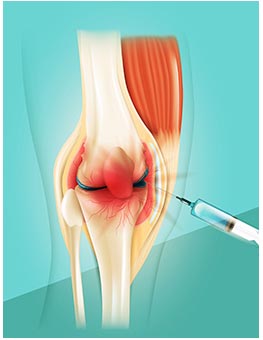- L’acido ialuronico: un componente del “liquido sinoviale”, un fluido normalmente prodotto dal nostro organismo e che serve a ridurre la frizione tra le estremità delle ossa
- Il collagene: un componente naturale di legamenti, tendini, capsule, ossa, cartilagini e muscoli
- Ginocchio
- Spalla
- Gomito
- Anca
- Polso
- Caviglia
- Piccole articolazioni di mano e piede
- Infiammatorio da trauma
- Iper stimolazione dell'’articolazione
- Malattie osteoarticolari come artrosi, artrite o usura della cartilagine
- Infezione articolare o periarticolare
- Presenza di versamento di sangue nelle articolazioni (emartro)
- Impossibilità a sospendere la terapia anticoagulante per patologie cardiache o della coagulazione
- Alcune volte possono verificarsi reazioni come:
- Dolore dell’articolazione interessata
- Gonfiore in sede di iniezione
- Rossore della sede di infiltrazione
- Senso di calore dell’articolazione
Cosa sono le infiltrazioni articolari?
Le infiltrazioni intra e periarticolari consistono nell’introduzione di un farmaco direttamente all’interno dell’articolazione o nel tessuto circostante.
Il preparato viene iniettato dentro l’articolazione o, in determinate condizioni, nel tessuto circostante (peri-articolare), sia per placare il dolore, sia per curare la causa che lo ha scatenato (infiammazione, degenerazione dei tessuti, ecc).

Quali farmaci si utilizzano?
I farmaci che possono essere utilizzati sono antinfiammatori (cortisonici) e antidolorifici (anestetici locali). Tra i preparati più comuni abbiamo:
Quando sono indicate?
Le infiltrazioni sono particolarmente indicate nel caso di dolore alle articolazioni di:
Le cause del dolore possono essere di vario tipo:
Proprio in quest’ultimo caso, cioè per le malattie osteoarticolari, è particolarmente indicata l’infiltrazione di acido ialuronico perché ripristina le proprietà del liquido sinoviale (contenuto all’interno dell’articolazione) che, grazie a questa sostanza, torna la a svolgere sua normale funzione di “cuscinetto”, placando di conseguenza il dolore.
Le infiltrazioni articolari e peri-articolari non sono dolorose e possono migliorare sensibilmente il dolore di cui soffri
Devo prepararmi in qualche modo alle infiltrazioni?
Le infiltrazioni non richiedono una preparazione specifica però è generalmente molto utile fare prima alcuni esami del sangue per valutare la coagulazione e prevenire la formazione di ematomi dopo la procedura.
Se assumi farmaci anticoagulanti può esserti richiesto di sospenderli (come raccomandato dalle linee guida internazionali). Dunque ricordati sempre di portare con te la lista di farmaci che assumi e di far presente se sei a conoscenza di soffrire di patologie della coagulazione del sangue.
Quando sono controindicate?
In alcuni casi non è possibile effettuare le infiltrazioni, perché potrebbero non essere sicure per il tuo stato di salute.
Per esempio, in caso di:
Come devo comportarmi dopo l’infiltrazione?
Dopo l’infiltrazione è importante tenere l’articolazione a riposo per almeno ventiquattro ore e applicare del ghiaccio, avendo cura di frapporre tra il ghiaccio e la cute degli strati di stoffa per evitare lesioni
Esistono effetti collaterali?
Gli effetti collaterali sono pochi e la maggior parte delle volte momentanei.
Di solito durano dalle ventiquattro alle quarantotto ore e scompaiono spontaneamente
Le infiltrazioni possono evitare la chirurgia?
Nei casi di grave artrosi dell'articolazione, le infiltrazioni possono sicuramente migliorare il dolore e anche lo stato infiammatorio, ritardando di conseguenza l’eventuale l’intervento chirurgico che solitamente consiste nella sostituzione dell’articolazione con una protesi.
Sarà mia cura valutare nel dettaglio il tuo caso specifico e accompagnarti nel percorso più adeguato per la tua salute